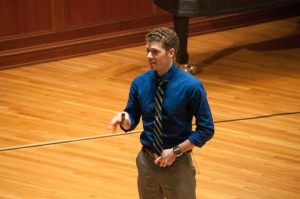By Kristen Lauletti
Correspondent
As part of the Brown Bag Series, guest speaker Tom Hipper visited the College in the Mayo Concert Hall on Friday, March 21, for “Communication During Disasters: How Social Media and Crisis Mapping Are Changing the Field.”

Tom Hipper, an alumnus of the College — as well as Penn State University and Johns Hopkins University — gave insight into just how powerful communication with the public can be in times of distress, danger or threat.Hipper, currently the Public Health Planner at the Center for Public Health Readiness and Communication at Drexel University, explained that the field of Crisis and Emergency Risk Communication (CERC) can offer valuable tools and knowledge on how to successfully deliver and share information.
“Stress can reduce the ability to process information by 80 percent,” Hipper said.
Because of this, communicating during a crisis requires a set of guidelines. Hipper outlined the six principles of CERC that are essential in relaying important messages to the public.
Not only is it important to be first, but you must also be right. This includes being honest about when you know something, but also when you don’t know something.
“I thought it was really interesting that when you’re honest, even about things that you don’t know, it rarely creates panic. I thought it would have the opposite effect,” senior psychology major Francesca Zett said.
Hipper also discussed how it’s necessary to be credible. Examples such as the Anthrax attacks in 2001 demonstrated an effort to avoid overreactions and panic. This, however, led to public distrust once non-credible information was given to it.
Expressing empathy is also important when communicating to people in a time of crisis to show there’s understanding of what they’re going through. Similarly, showing respect demonstrates an understanding that not all disasters are the same and therefore shouldn’t be treated as such.
A last core CERC principle is to promote action among the people who are being communicated to.
Public action has proven to be effective in recent disasters, especially with the use of Twitter. With people receiving tweets about the D.C. Quake 30 seconds before they felt it, it truly showed how this social tool is a powerful means of communication.
With the use of crisis mapping, Hipper explains how social media can be harnessed specifically for an overall public good when the stakes are high. With the use of crowdsourcing, citizens take the active role as participants and contribute pieces of information that can build overall awareness and understanding amongst the public about a particular crisis.
“I love the idea that people can play a more proactive role during a disaster through crisis mapping,” junior communication studies major Ashley McKenna said. “It makes them feel a part of risk decision-making and aiding the process.”






